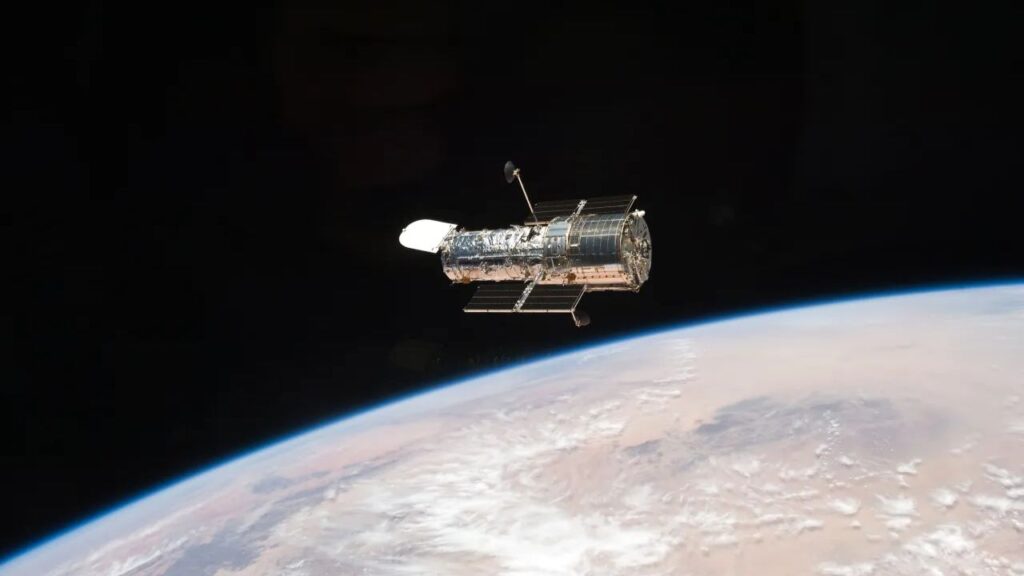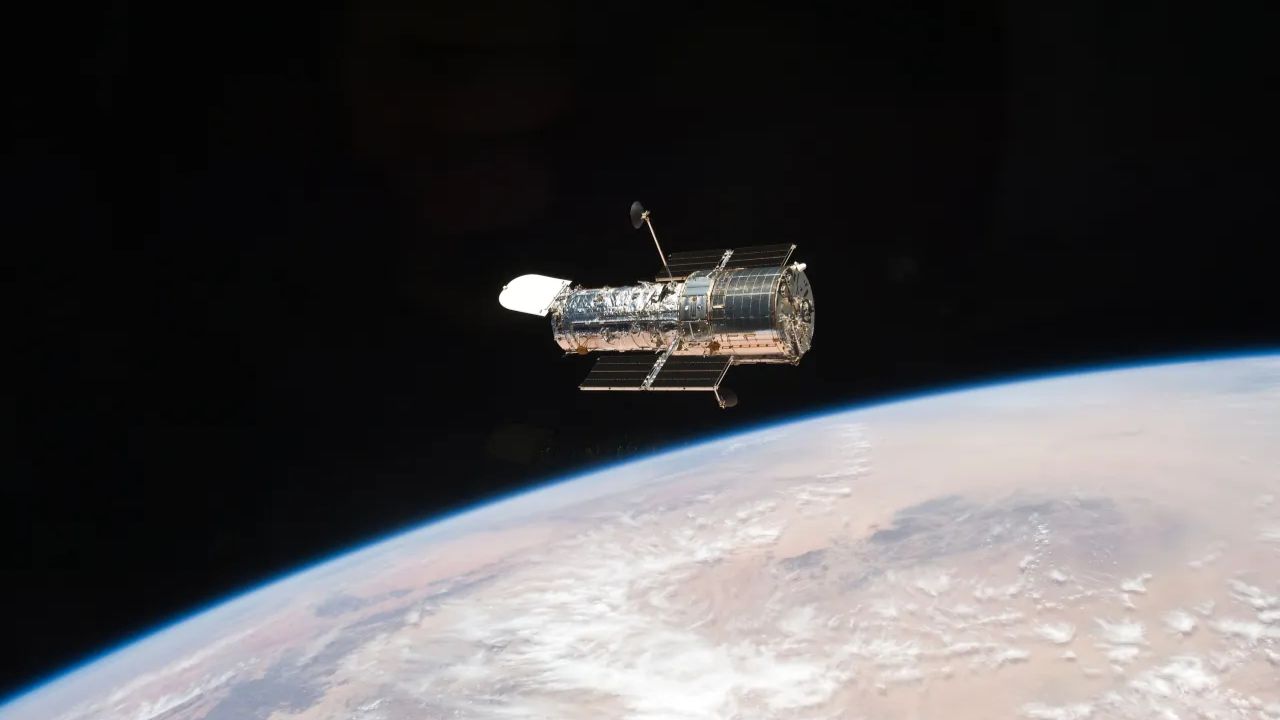Hubble Space Telescope, NASA Hubble news, Hubble one-gyro mode, Hubble gyroscope issue, Hubble telescope updates, NASA space missions, Hubble scientific discoveries, space telescope operations, Hubble safe mode, Hubble and James Webb collaboration
“NASA’s Hubble Space Telescope has successfully resumed daily science operations using a new one-gyro mode after a recent gyroscope failure. Discover how Hubble continues to provide groundbreaking scientific data and its collaboration with the James Webb Space Telescope

NASA’s Hubble Restarts Science in New Pointing Mode: Ensuring Continued Cosmic Discoveries
NASA’s Hubble Space Telescope, a cornerstone of modern astronomy, has returned to daily science operations after transitioning to an alternate operating mode that uses only one gyroscope. This adaptation ensures that Hubble continues to provide valuable scientific data, even as it navigates challenges associated with aging hardware.
A Safe Mode Triggered by Gyro Issues
On May 24, Hubble entered safe mode due to issues with one of its gyroscopes (gyros). These gyros are critical for measuring the telescope’s slew rates, which are essential for determining and controlling the direction in which the telescope is pointed. Over the past six months, one gyro had been returning faulty readings, causing multiple suspensions of science operations. As a result, the Hubble team decided to transition from a three-gyro operating mode to a one-gyro mode. This strategic shift enables more consistent science observations while preserving another operational gyro for future use.
The Transition to One-Gyro Mode
The decision to switch to one-gyro mode was not taken lightly. NASA discussed this transition in detail during a media teleconference on June 4, explaining the rationale and the anticipated impacts on Hubble’s operations. The team will continue to monitor the problematic gyro to determine if it can stabilize and be used again in the future.
Operating with a single gyro does introduce some limitations. For example, the precision in pointing may be slightly reduced, and certain observations may require more careful planning. However, the Hubble team has developed strategies to mitigate these limitations, ensuring that the telescope can continue to perform most of its science observations effectively.
Stability and Functionality
Despite these challenges, the Hubble Space Telescope and its instruments remain stable and functional. The transition to one-gyro mode has been successful, and Hubble has resumed its regular schedule of observations. NASA anticipates further refinements to optimize operations as the team gains more experience with this new mode.
Hubble’s Remarkable Longevity
Launched in 1990, Hubble has far exceeded its original mission expectations. Initially designed for a 15-year mission, the telescope has been observing the universe for over three decades, recently celebrating its 34th anniversary. Hubble’s extended mission is a testament to the robust design and the dedication of the teams who have maintained and upgraded the telescope over the years.
Major Scientific Contributions
Hubble’s contributions to astronomy are vast and transformative. From capturing the iconic Pillars of Creation to providing evidence of dark energy, Hubble has revolutionized our understanding of the universe. It has observed distant galaxies, contributed to the discovery of exoplanets, and provided insights into the processes of star formation and galaxy evolution.
Some of Hubble’s greatest scientific discoveries include:
- Deep Field Images: Capturing the deepest images of the universe, revealing thousands of previously unseen galaxies.
- Dark Energy: Providing data that led to the discovery of dark energy, a mysterious force accelerating the expansion of the universe.
- Exoplanet Atmospheres: Detecting and analyzing the atmospheres of planets beyond our solar system.
- Stellar Populations: Offering detailed views of star clusters and the lifecycle of stars.
- Black Holes: Observing the regions around supermassive black holes at the centers of galaxies.
The Gyroscope Issue: A Closer Look
Gyroscopes are essential for Hubble’s precision pointing. These devices measure the rate of rotation, helping to control the telescope’s orientation. Hubble was equipped with six gyros at launch, and over the years, it has relied on them to maintain stability and accuracy.
Gyroscope Failure and Recovery
The recent gyro issue is part of a series of challenges Hubble has faced with its aging equipment. Gyroscopes are mechanical devices and, like all such equipment, are subject to wear and tear. The Hubble team has developed protocols for handling gyro failures, including switching to backup gyros and, as in this case, operating with fewer gyros.
When Hubble’s gyros provide faulty readings, the telescope’s onboard systems detect the anomaly and automatically enter safe mode. This precautionary measure ensures that the telescope remains protected while engineers diagnose and address the issue.
The Future of Hubble
NASA is confident that Hubble will continue making significant contributions to science throughout this decade and possibly into the next. The telescope is expected to work in tandem with newer observatories, such as the James Webb Space Telescope (JWST), to expand our understanding of the universe.
Collaborating with the James Webb Space Telescope
The James Webb Space Telescope, scheduled for launch in 2021, represents the next generation of space observatories. While JWST will observe the universe in the infrared spectrum, Hubble continues to excel in the visible and ultraviolet ranges. Together, these telescopes will provide a more comprehensive view of the cosmos.
Complementary Observations
Hubble and JWST will conduct complementary observations, with Hubble providing high-resolution images and JWST offering detailed infrared data. This collaboration will enhance our ability to study phenomena such as star formation, galaxy evolution, and the characteristics of exoplanets.
Extended Mission Planning
NASA is also exploring ways to extend Hubble’s mission even further. This could involve additional servicing missions or the development of new technologies to support the telescope’s operations. The goal is to ensure that Hubble remains a valuable scientific asset for as long as possible.
The Importance of Continued Support
As Hubble continues its mission, ongoing support from the scientific community and the public remains crucial. Funding for maintenance and operations, as well as for the analysis of Hubble’s data, is essential for maximizing the telescope’s scientific output.
Educational Impact
Hubble’s discoveries have also had a profound impact on education and public outreach. The stunning images captured by Hubble have inspired millions and brought the wonders of the universe closer to people around the world. Educational programs and resources based on Hubble’s findings continue to engage and educate students, fostering a new generation of scientists and astronomers.
Conclusion
NASA’s successful transition of the Hubble Space Telescope to a one-gyro operating mode marks a significant milestone in the telescope’s storied history. Despite the challenges posed by aging equipment, Hubble remains a vital tool for scientific discovery. As it continues to observe the universe, Hubble’s contributions will be complemented by the James Webb Space Telescope and other future observatories.
The resilience of the Hubble team and the support of the broader scientific community ensure that this remarkable telescope will continue to unveil the mysteries of the cosmos for years to come. Hubble’s legacy is a testament to human ingenuity and our relentless quest for knowledge about the universe we inhabit.
Read More
